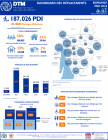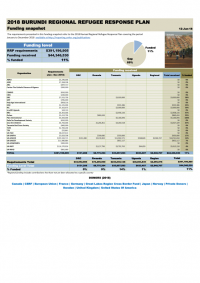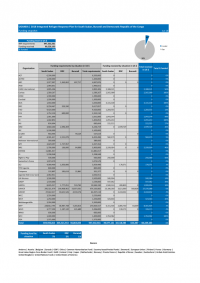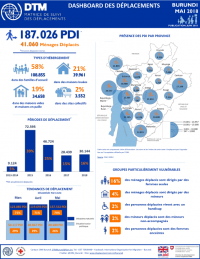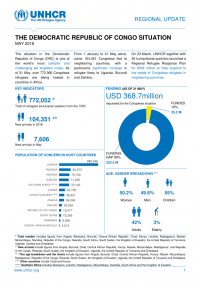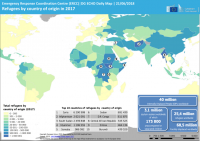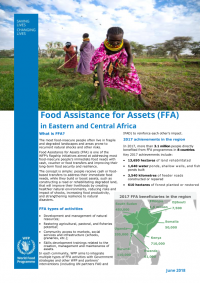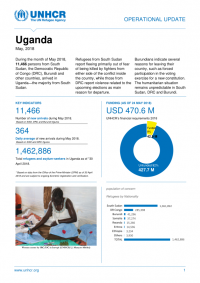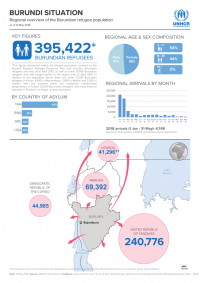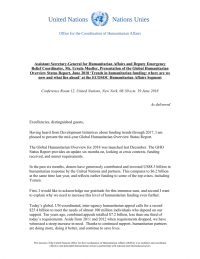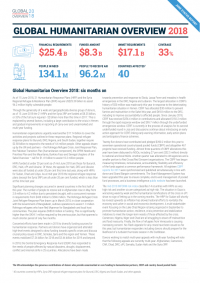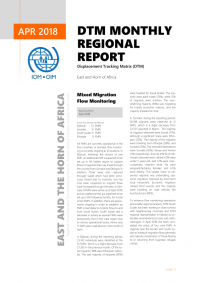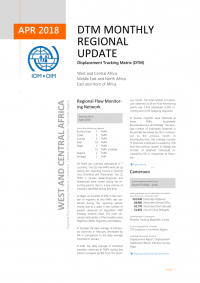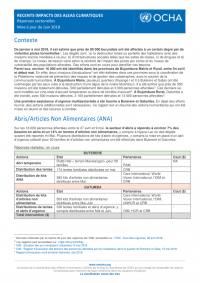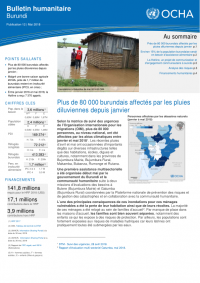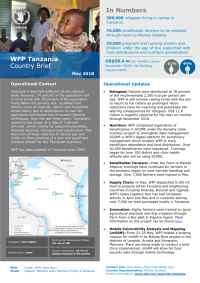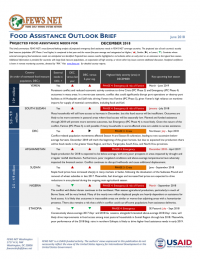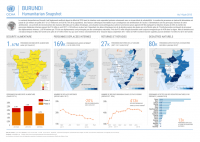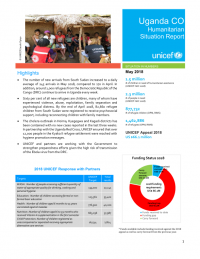Burundi
OngoingOverview
Key Content
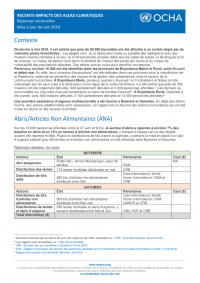 OCHA: Burundi: Récent impacts des aléas climatiques - Réponses sectorielles Mise à jour de Juin 2018
OCHA: Burundi: Récent impacts des aléas climatiques - Réponses sectorielles Mise à jour de Juin 2018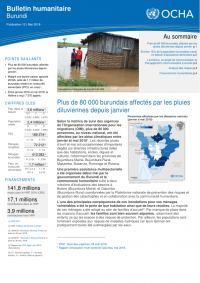 OCHA: Burundi : Bulletin Humanitaire | Publication 12 | Mai 2018
OCHA: Burundi : Bulletin Humanitaire | Publication 12 | Mai 2018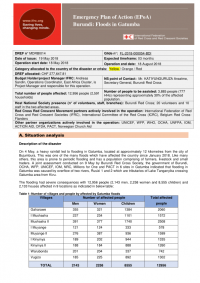 IFRC: Burundi: Floods in Gatumba - Emergency Plan of Action (EPoA) DREF n° MDRBI014
IFRC: Burundi: Floods in Gatumba - Emergency Plan of Action (EPoA) DREF n° MDRBI014
Appeals & Response Plans
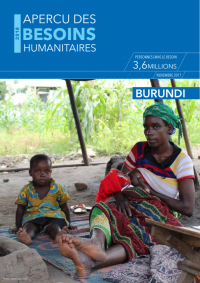 OCHA: Burundi: Aperçu des besoins humanitaires 2018 (Novembre 2017)
OCHA: Burundi: Aperçu des besoins humanitaires 2018 (Novembre 2017)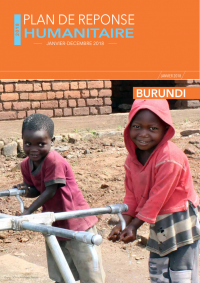 OCHA: Burundi: Humanitarian Response Plan 2018 - Janvier - Décembre 2018 (Janvier 2018)
OCHA: Burundi: Humanitarian Response Plan 2018 - Janvier - Décembre 2018 (Janvier 2018)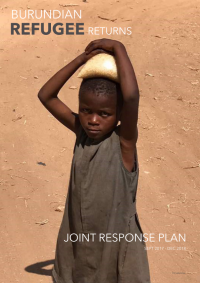 UNCT Burundi: Burundian Refugee Returns: Joint Response Plan Sept 2017 - Dec 2018
UNCT Burundi: Burundian Refugee Returns: Joint Response Plan Sept 2017 - Dec 2018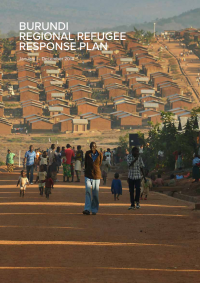 UNHCR: Burundi Regional Refugee Response Plan 2018, January - December 2018
UNHCR: Burundi Regional Refugee Response Plan 2018, January - December 2018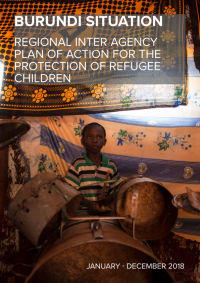 UNHCR: Burundi Situation: Regional Inter Agency Plan of Action for the Protection of Refugee Children (January - December 2018)
UNHCR: Burundi Situation: Regional Inter Agency Plan of Action for the Protection of Refugee Children (January - December 2018)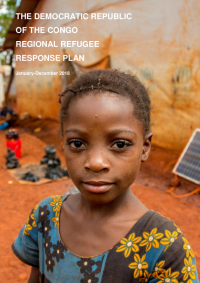 UNHCR: The Democratic Republic of the Congo Regional Refugee Response Plan January-December 2018
UNHCR: The Democratic Republic of the Congo Regional Refugee Response Plan January-December 2018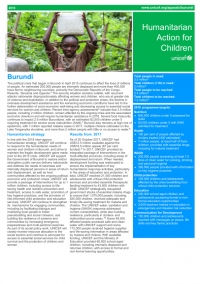 UNICEF: Humanitarian Action for Children 2018 - Burundi
UNICEF: Humanitarian Action for Children 2018 - Burundi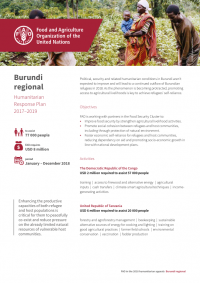 FAO: Burundi - Regional Humanitarian Response Plan 2017–2019
FAO: Burundi - Regional Humanitarian Response Plan 2017–2019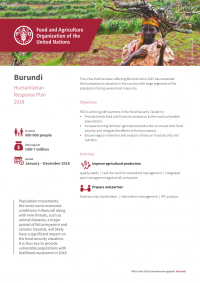 FAO: Burundi - Humanitarian Response Plan 2018
FAO: Burundi - Humanitarian Response Plan 2018
Useful Links
Disasters
- Burundi: Floods - Apr 2018
- East Africa: Armyworm Infestation - Mar 2017
- Burundi: Malaria Outbreak - Mar 2017
- Burundi: Cholera Outbreak - Jul 2016
- Burundi: Floods - Nov 2015
- Burundi/Tanzania: Cholera Outbreak - May 2015
- Burundi: Landslides and Floods - Mar 2015
- Burundi: Floods and Landslides - Feb 2014
- Burundi: Cholera Outbreak - Oct 2012
- Burundi: Cholera Outbreak - Aug 2011
Most read (last 30 days)
- Burundi: Humanitarian Snapshot (Au 14 juin 2018)
- UNICEF Great Lakes Situation (May 2018)
- GIEWS Country Brief: Burundi 11-June-2018
- Atrocity Alert No. 106, 23 May 2018: Burundi, Central African Republic and Sudan
- Conseil de sécurité: l’Envoyé spécial appelle les autorités du Burundi à envoyer un « signal fort » en faveur de la reprise du dialogue politique
Le dashboard DTM du mois de mai 2018 couvre toutes les 18 provinces du Burundi. La DTM a identifié 187 026 personnes déplacées internes (PDI) au sein de 41 060 ménages déplacés. 3 552 PDI (2%) vivent dans des camps de déplacés, 108 855 PDI (58%) vivent dans des familles d’accueil, 34 658 PDI (19%) vivent dans des maisons vides et en paille, 39 961 (21%) vivent dans des maisons louées. 74% des PDI (137 532) ont été déplacées à la suite de désastres naturels, tandis que 26% des PDI (48 680) ont été déplacées en raison de la situation socio-politique.
The situation in the Democratic Republic of Congo (DRC) is one of the world’s most complex and challenging yet forgotten crises. As of 31 May, over 772,000 Congolese refugees are being hosted in countries in Africa.
From 1 January to 31 May alone, some 104,351 Congolese fled to neighboring countries, with a particularly significant increase in refugee flows to Uganda, Burundi and Zambia.
What is FFA?
The most food-insecure people often live in fragile and degraded landscapes and areas prone to recurrent natural shocks and other risks.
Food Assistance for Assets (FFA) is one of the WFP’s flagship initiatives aimed at addressing most food-insecure people’s immediate food needs with cash, voucher or food transfers and improving their long-term food security and resilience.
During the month of May 2018, 11,466 persons from South Sudan, the Democratic Republic of Congo (DRC), Burundi and other countries, arrived in Uganda—the majority from South Sudan.
Refugees from South Sudan report fleeing primarily out of fear of being killed by fighters from either side of the conflict inside the country, while those from DRC report violence related to the upcoming elections as main reason for departure.
*The figures presented reflect the refugee population covered by the Burundi Regional Refugee Response Plan and includes Burundian refugees who fled since April 2015, as well as some 37,000 Burundian refugees who had sought asylum in the region prior to April 2015. In addition to the population above, there are some 13,200 Burundian refugees in Kenya, 4,800 in Mozambique, 3,600 in Malawi and 2,500 in Zambia who are assisted within the respective country-level programmes. A further 23,000 Burundian refugees, who have lived for decades in Tanzania, no longer receive assistance.
‘Trends in humanitarian funding: where are we now and what lies ahead’ at the ECOSOC Humanitarian Affairs Segment
Conference Room 12, United Nations, New York, 08:30 a.m. 19 June 2018
As delivered
Excellencies, distinguished guests,
Having heard from Development Initiatives about funding trends through 2017, I am pleased to present the mid-year Global Humanitarian Overview Status Report.
Global Humanitarian Overview 2018: six months on
As of 15 June 2018, 21 Humanitarian Response Plans (HRP) and the Syria Regional Refugee & Resilience Plan (3RP) require US$25.39 billion to assist 96.2 million highly vulnerable people.
Mixed Migration Flow Monitoring
Regional Flow Monitoring Network
Contexte
De janvier à mai 2018, il est estimé que près de 80 000 burundais ont été affectés à un certain degré par de violentes pluies torrentielles. Les dégâts sont : a) la destruction totale ou partielle des habitations avec des maisons encore inondées à ce jour, b) d’infrastructures sociales telles que les salles de classe, c) de dingues et d) de champs. Le niveau de besoin varie selon la sévérité de l’impact des pluies par zones et du niveau de vulnérabilité des populations affectées. Des efforts sont en cours pour identifier ces besoins.
POINTS SAILLANTS
• Plus de 80 000 burundais affectés par les pluies diluviennes depuis janvier ;
• Malgré une bonne saison agricole 2018A, près de 1,7 million de burundais restent en insécurité alimentaire (IPC3, en crise) ;
• Entre janvier 2016 et mai 2018, la Hotline a reçu 7 370 appels.
CHIFFRES CLES
Pop. dans le besoin 3,6 millions
Population ciblée 2,4 millions
PDI 169 374
Réfugiés congolais 72 212
Réfugiés burundais 413 283
Pers. en insécurité alimentaire 1,7 million
In Numbers
309,000 refugees living in camps in Tanzania
70,000 smallholder farmers to be assisted through Farm to Market Alliance
29,000 pregnant and nursing women and children under the age of two supported with food distributions and nutrition sensitization
US$58.4 m six months (JuneNovember 2018) net funding requirements
Operational Context
PROJECTED FOOD ASSISTANCE NEEDS FOR DECEMBER 2018
Le contexte humanitaire au Burundi s'est légèrement amélioré depuis le début de 2018 mais la situation reste cependant précaire notamment avec un niveau élevé de vulnérabilité. Le nombre de personnes en insécurité alimentaire est passé de 2,6 millions en juillet 2017 à 1,67 million en avril 2018 (15% de la population). Des facteurs climatiques favorables et par conséquence une amélioration de l’accès à l’alimentation sont les principaux facteurs de cette amélioration.
Suite à la notification d’une flambée de maladie à virus Ebola dans la province de l’Équateur, en République démocratique du Congo, le 5 mai 2018, l’OMS a réalisé une évaluation formelle rapide des risques qui a démontré que le risque pour la santé publique est élevé au niveau régional.
This year, on the International Day for the Elimination of Sexual Violence in Conflict, we celebrate ten years since the adoption of the United Nations Security Council’s landmark resolution 1820 (2008), which classified the use of conflict-related sexual violence as an impediment to the restoration of international peace and security.
Highlights
The number of new arrivals from South Sudan increased to a daily average of 245 arrivals in May 2018, compared to 170 in April. In addition, around 1,000 refugees from the Democratic Republic of the Congo (DRC) continue to arrive in Uganda every week.


